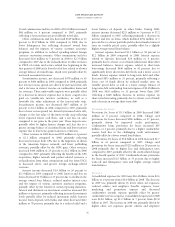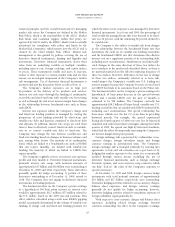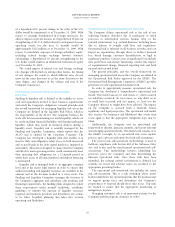American Express 2009 Annual Report Download - page 43
Download and view the complete annual report
Please find page 43 of the 2009 American Express annual report below. You can navigate through the pages in the report by either clicking on the pages listed below, or by using the keyword search tool below to find specific information within the annual report.
2009 FINANCIAL REVIEW
AMERICAN EXPRESS COMPANY
The following discussion includes information on both a
GAAP and managed basis. The managed basis presentation
includes debt issued in connection with the Company’s
lending securitization activities, which are off-balance sheet.
For a discussion of managed basis and management’s
rationale for such presentation, refer to the USCS discussion
below. The Company had the following consolidated debt, on
both a GAAP and managed basis, and customer deposits
outstanding as of December 31:
(Billions) 2009 2008
Short-term borrowings $ 2.3 $ 9.0
Long-term debt 52.3 60.0
Total debt (GAAP basis) 54.6 69.0
Off-balance sheet securitizations 28.3 29.0
Total debt (managed basis) 82.9 98.0
Customer deposits 26.3 15.5
Total debt (managed) and customer deposits $109.2 $113.5
The Company’s funding strategy for 2010 is to raise funds to
meet short-term borrowings outstanding, which includes
short-term deposits, seasonal and other working capital
needs, changes in receivables and other asset balances, while
maintaining sufficient cash and readily-marketable securities,
which are easily convertible to cash, in order to be able to
satisfy all maturing funding obligations for a 12 month
period. The Company has $7.4 billion of unsecured long-term
debt, $10.2 billion of asset securitizations, and $2.6 billion of
long-term deposits that will mature during 2010.
The Company’s equity capital and funding strategies are
designed to maintain appropriate and stable debt ratings from
the major credit rating agencies (collectively the “Credit
Rating Agencies”), Moody’s Investor Services (Moody’s),
Standard & Poor’s (S&P), Fitch Ratings (Fitch), and
Dominion Bond Rating Services (DBRS). There have been no
changes to the ratings since second quarter 2009, however,
both DBRS and S&P have recently revised their ratings
outlook from “Negative” to “Stable”.
Credit
Agency Entity Rated
Short-
Term
ratings
Long-
Term
ratings Outlook
DBRS All rated entities R-1
(middle)
A
(high)
Stable
Fitch All rated entities F1 A+ Negative
Moody’s TRS and rated
operating
subsidiaries
Prime-1 A2 Stable
American
Express
Company
Prime-2 A3 Negative
S&P All rated entities A-2 BBB+ Stable
Downgrades in the Company’s unsecured debt or asset
securitization program’s securities ratings could result in
higher interest expense on the Company’s unsecured debt and
asset securitizations, as well as higher fees related to
borrowings under its unused lines of credit. In addition to
increased funding costs, declines in credit ratings could
reduce the Company’s borrowing capacity in the unsecured
debt and asset securitization capital markets. The Company
believes that the change in its funding mix, which now
includes an increasing proportion of U.S. retail deposits,
should reduce the impacts that credit rating downgrades
would have on the Company’s funding capacity and costs.
SHORT-TERM FUNDING PROGRAMS
Short-term borrowings, such as commercial paper, are
defined as any debt or time deposit with an original maturity
of 12 months or less. The Company’s short-term funding
programs are used primarily to meet working capital needs,
such as managing seasonal variations in receivables balances.
Short-term borrowing decreased significantly in 2009 as part
of the change in the Company’s funding mix. The amount of
short-term borrowing issued in the future will depend on the
Company’s funding strategy, its needs and market conditions.
The Company had the following short-term borrowings
outstanding as of December 31:
(Billions) 2009 2008
Credco:
Commercial paper $1.0 $7.3
Other —0.1
Centurion Bank and FSB:
Federal funds purchased —0.5
Other 1.3 1.1
Total $2.3 $9.0
The Company’s short-term borrowings as a percentage of
total debt as of December 31 were as follows:
2009 2008
Short-term borrowings as a percentage of total debt
(GAAP basis) 4.3% 13.0%
The Company had continuous access to the commercial paper
market during 2009, and as of December 31, 2009, the
Company had $1.0 billion of commercial paper outstanding.
Average commercial paper outstanding was $2.0 billion and
$10.8 billion in 2009 and 2008, respectively.
American Express Credit Corporation’s (Credco) total
back-up liquidity coverage, which includes its undrawn
committed bank facilities, was in excess of 100 percent of its
net short-term borrowings as of December 31, 2009 and 2008.
41
























